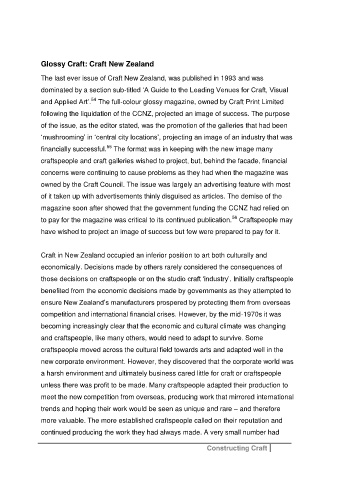Page 232 - Constructing Craft
P. 232
Glossy Craft: Craft New Zealand
The last ever issue of Craft New Zealand, was published in 1993 and was
dominated by a section sub-titled ‘A Guide to the Leading Venues for Craft, Visual
54
and Applied Art’. The full-colour glossy magazine, owned by Craft Print Limited
following the liquidation of the CCNZ, projected an image of success. The purpose
of the issue, as the editor stated, was the promotion of the galleries that had been
‘mushrooming’ in ‘central city locations’, projecting an image of an industry that was
55
financially successful. The format was in keeping with the new image many
craftspeople and craft galleries wished to project, but, behind the facade, financial
concerns were continuing to cause problems as they had when the magazine was
owned by the Craft Council. The issue was largely an advertising feature with most
of it taken up with advertisements thinly disguised as articles. The demise of the
magazine soon after showed that the government funding the CCNZ had relied on
56
to pay for the magazine was critical to its continued publication. Craftspeople may
have wished to project an image of success but few were prepared to pay for it.
Craft in New Zealand occupied an inferior position to art both culturally and
economically. Decisions made by others rarely considered the consequences of
those decisions on craftspeople or on the studio craft ‘industry’. Initially craftspeople
benefited from the economic decisions made by governments as they attempted to
ensure New Zealand’s manufacturers prospered by protecting them from overseas
competition and international financial crises. However, by the mid-1970s it was
becoming increasingly clear that the economic and cultural climate was changing
and craftspeople, like many others, would need to adapt to survive. Some
craftspeople moved across the cultural field towards arts and adapted well in the
new corporate environment. However, they discovered that the corporate world was
a harsh environment and ultimately business cared little for craft or craftspeople
unless there was profit to be made. Many craftspeople adapted their production to
meet the new competition from overseas, producing work that mirrored international
trends and hoping their work would be seen as unique and rare – and therefore
more valuable. The more established craftspeople called on their reputation and
continued producing the work they had always made. A very small number had
Constructing Craft

